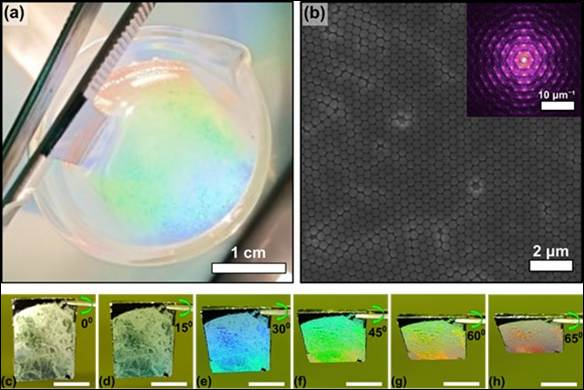Scientists have now found a way to harness a property known as structural coloration to create tunable color-shifting materials using tiny plastic beads that can be used for wearable sensors, anti-counterfeit tags, display technologies and even eco-friendly paints.
The colour of the peacock’s feathers change depending on how you look at it, varying between shimmering blues and greens. Similar effect is observed in the radiant wings of a butterfly. These are not colors made from paint or pigment, but from the structure of the surface itself.
Researchers at the Centre for Nano and Soft Matter Sciences (CeNS), Bengaluru, an autonomous institute of Department of Science and Technology (DST), have uncovered how structural colors arising from nanoscale geometry can be finely tuned by varying both the size of colloidal spheres and the angle of light incidence.

Fig: (a) Structural colors exhibited by a monolayer of PS spheres (dini = 401 nm) self-assembled at the A-W interface into a hexagonally ordered close-packed (CP) state. (b) Field emission scanning electron microscope image of PS monolayer in the CP state, inset shows FFT of the image. (c-h) Structural colors exhibited by the self-assembled PS spheres for different tilt angles. The scale bar represents 0.5 cm (c-h).
At the heart of this breakthrough are polystyrene nanospheres, each about 400 nanometers wide—roughly a thousand times smaller than a grain of sand. These spheres naturally arrange themselves into a flat, hexagonal pattern when floated on water—a bit like a molecular-level jigsaw puzzle. This self-assembly, driven by simple surface forces, results in what the scientists call a close-packed monolayer.
Once this tiny layer is formed, the researchers use a precise method called reactive ion etching—a kind of nano-scale sandblasting—to gently shrink the spheres without disturbing their neat arrangement. This size reduction leads to a “non-close-packed” layout. Light behaves differently as it hits the altered surface.
When light reflects off this nanostructured layer, its interaction with the tiny spheres causes certain wavelengths (colors) to be amplified or diminished. By tilting the surface or changing the viewing angle, the reflected color shifts—typically towards blue. This phenomenon is predictable and tunable due to the way in which the spacing and size of the spheres affect light’s path.
Unlike ordinary colorants, which fade over time or under sunlight, structural colors are durable and vibrant. This makes them ideal for a host of futuristic applications.
The research stands out for its scalability. The scientists used a cost-effective, “bottom-up” technique—letting nature carry out the self-assembling of the tiny particles organize. A little etching unlocks their ability to dance with light.
This work helps understanding and manipulating the fundamental ways in which light interacts with matter. By showing how slight changes in geometry can lead to dramatic visual effects, the CeNS team has opened the door to custom-designed optical materials that don’t rely on harmful dyes or complex fabrication processes.
Their study, recently published in the Journal of Applied Physics, explores how size-reduced monolayers of self-assembled polystyrene (PS) nanospheres exhibit angle-dependent optical properties due to collective light-matter interactions within the monolayer.
This research underscores the efficacy of colloidal self-assembly at the air-water interface, combined with reactive ion etching, in fabricating large-area, size-tunable monolayers of polystyrene nanospheres.
It provides an approach for developing advanced materials with customizable optical characteristics by elucidating the relationship between structural parameters and optical response.
